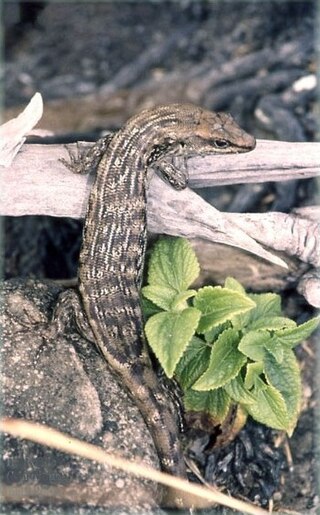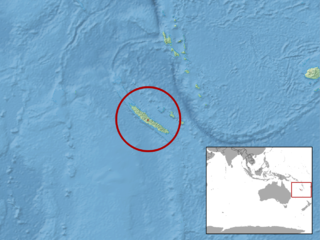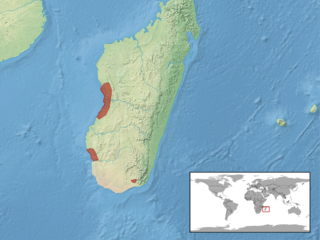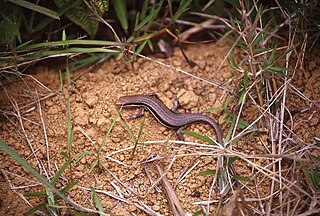
Skinks are lizards belonging to the family Scincidae, a family in the infraorder Scincomorpha. With more than 1,500 described species across 100 different taxonomic genera, the family Scincidae is one of the most diverse families of lizards. Skinks are characterized by their smaller legs in comparison to typical lizards and are found in different habitats except arctic and subarctic regions.
Feylinia boulengeri is a species of skink, a lizard in the family Scincidae. The species is native to Central Africa.

Chioninia coctei is an extinct species of lizard that was at one time known to inhabit the islets of Branco and Raso in the Cape Verde islands of the Atlantic Ocean, islets rendered deserts by human-caused habitat destruction. None has been observed since the early 20th century, and the species was officially declared extinct in 2013.
Phoboscincus is a small genus of skinks, lizards in the family Scincidae. There are two known species in the genus Phoboscincus. Both species are found on various island of New Caledonia.

Leiolopisma telfairii, also known commonly as the Round Island ground skink, the Round Island skink, and Telfair's skink, is a species of lizard in the family Scincidae. The species is endemic to Round Island, one of the islands of Mauritius.

The terror skink, also called commonly Bocourt's terrific skink, Bocourt's eyelid skink and Bocourt's skink, is a species of lizard in the family Scincidae. The species is endemic to the Île des Pins, a small islet off the coast of New Caledonia. First described in 1876, the species was presumed to be extinct, but was rediscovered in 1993, and since then several individuals have been seen. Because of its small area of occupation and small population size, the International Union for Conservation of Nature has assessed its conservation status as being "critically endangered".

Pseudemoia entrecasteauxii, also known commonly as Entrecasteaux's skink, the southern grass skink, the tussock cool-skink, and the tussock skink, is a species of lizard in the family Scincidae. The species is endemic to Australia.

Geoscincus is a monotypic genus of skinks: the only accepted species is Geoscincus haraldmeieri.
Trachylepis bayonii, also known commonly as Bayão's skink, Bayon's mabuya, and Bayon's skink, is a species of lizard in the family Scincidae. The species is endemic to Africa. There are two subspecies.

Chioninia vaillantii, also known commonly as Vaillant's mabuya or Vaillant's skink, is a species of skink in the family Scincidae. The species is endemic to the Cape Verde Islands. There are two recognized subspecies.
Dasia vyneri, also known commonly as Shelford's skink and Vyner's tree skink, is a species of lizard in the family Scincidae. The species is native to Southeast Asia.
Lacertaspis chriswildi, also known commonly as Chris Wild's snake-eyed skink, Chris-Wild's snake-eyed skink, and Chris-Wild's lidless skink, is a species of lizard in the family Scincidae. The species is endemic to Cameroon.
Fuhn's five-toed skink is a species of lizard in the family Scincidae. The species is endemic to Cameroon.

Lioscincus steindachneri, also known commonly as the white-lipped forest skink or Steindachner's ground skink, is a species of lizard in the family Scincidae. The species is endemic to New Caledonia.
Panaspis seydeli, also known as the Seydel's snake-eyed skink, is a species of lidless skink, a lizard in the family Scincidae. The species is known from the Democratic Republic of the Congo and Zambia.

Deplanche's shiny skink is a species of lizard in the family Scincidae. The species is endemic to New Caledonia.

Trachylepis dumasi is a species of skink, a lizard in the family Scincidae. The species is endemic to Madagascar.

Trachylepis gravenhorstii, also known commonly as Gravenhorst's mabuya, is a species of skink, a lizard in the family Scincidae. The species is endemic to Madagascar.
Papuascincus buergersi is a species of skink, a lizard in the family Scincidae. The species is endemic to Papua New Guinea.

Plestiodon dugesii, also known commonly as Dugès' skink, Duges's skink, and eslabon in Mexican Spanish, is a species of lizard in the family Scincidae. The species is endemic to Mexico.













